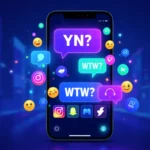In the last few years, our work culture has transformed more than ever before. One phrase that everyone—from corporate professionals to freelancers to casual social media users—keeps dropping into conversations is 🚀what does wfh mean🚀. Whether you spotted it in a Slack message, on TikTok, or in your HR email, this compact little abbreviation has become a permanent part of modern digital language.
But what exactly does it represent in today’s lifestyle? Why does everyone use it? And how do you use it correctly without sounding confused or out of touch?
Let’s break it down in the simplest, most relatable, and Gen-Z-approved way.
⚡ Quick Answer
WFH stands for “work from home.”
It’s used to describe doing your job remotely instead of going to an office or workplace. The phrase became mainstream globally due to the rise of digital businesses, remote teams, hybrid work models, and flexible job styles.
🏠 What “Work From Home” Really Means Today
The idea of doing your job from your bedroom, couch, or even a beachside Airbnb isn’t just a temporary trend—it has become a modern work lifestyle.
WFH simply means completing work tasks outside the traditional office environment. But socially and culturally, the term goes far beyond just location—it reflects freedom, flexibility, independence, and the rise of digital-first careers.
Why Everyone Loves This Term
Because it delivers:
- No traffic.
- No office rules.
- No uncomfortable dress codes.
- More freedom with time and space.
- The ability to work from anywhere.
But it also includes:
- More self-discipline
- Balancing home life with career
- Setting priorities without direct supervision
In short, WFH is the modern version of work-life balance.
📱 Where You’ll Commonly See “WFH” Used
If you’re scrolling through digital platforms, you’ll notice the abbreviation everywhere:
Work Messages
- “Hey, I’m WFH tomorrow. Ping me on Teams.”
- “The whole team is WFH today due to the weather.”
HR Announcements
- “Remote days are available—employees may choose WFH on Fridays.”
Social Media Captions
- “WFH vibes ✨ Coffee + laptop + cozy pajamas.”
Slack, Zoom, or Email Status
- “WFH – available from 9am to 5pm.”
Job Descriptions
- “This role offers WFH flexibility.”
It appears in career conversations, memes, TikTok videos, professional emails, and everyday chats—making it one of the most universal abbreviations of this decade.
🎧 The Rise of Remote Work Culture
The term exploded during global lockdowns when people had no choice but to take their work home. But what started as a necessity turned into a lifestyle people genuinely enjoy.
Modern companies now use:
- Hybrid schedules
- Fully remote teams
- Virtual meetings
- Cloud-based collaboration tools
With platforms like Zoom, Slack, Trello, Notion, and Google Workspace, remote work became smoother, easier, and way more efficient than old-school office systems.
And guess what? Gen-Z absolutely thrives in this environment—because freedom + flexibility is the new normal.
🔥 What WFH Looks Like in Real Life
Working from home isn’t just opening a laptop… it’s a full vibe.
✨ Typical WFH Scenario
You roll out of bed.
You grab a coffee.
You open your laptop.
You join a Zoom meeting while sitting in your sweatshirt and slippers.
You finish your tasks while your cat walks across your keyboard.
Yes, it’s modern productivity at its best.
💼 Professional Example
Marketing Manager:
“I’ll be WFH today but reachable on Slack if the client joins early.”
🧠 Student Example
University group chat:
“The prof said today’s tutorial is WFH—join through the Google Meet link.”
🧑💻 Freelancer Example
Graphic Designer:
“Most of my clients are overseas, so WFH is my permanent setup.”
Every age group uses it differently, but the meaning stays the same—your work is happening at home instead of the office.
📝 How to Use “WFH” in Sentences
Want to sound natural when using the term? Here are some casual, professional, and fun examples.
Casual Use
- “WFH today because the weather is not giving office energy.”
- “The best part of WFH? Unlimited snacks.”
Professional Use
- “I’ll be WFH for the next two days—please send updates via email.”
- “Our team follows a hybrid model with two WFH days per week.”
Social Media Use
- “WFH life → laptop, playlist, iced coffee, productivity mode.”
Friendly Conversation
- “Are you going to the office or WFH today?”
Using the abbreviation feels natural, modern, and universal—one reason it stuck around.
💡 Related Phrases You Should Know
To fully understand digital work terms, it helps to know the related abbreviations that appear with WFH:
WFH (Work From Home)
Doing your job remotely from home.
WFA (Work From Anywhere)
Remote freedom—could be a café, hotel, or even another country.
RTO (Return To Office)
Companies requiring employees to come back to physical offices.
WFH Setup
Your desk (or bed), laptop, chair, lighting, headphones, etc.
Hybrid Work
Some days in office, some days at home.
Remote Work / Telecommuting
Broad terms for working outside a traditional workspace.
These phrases all connect to the same digital lifestyle shift.
🌍 Why WFH Became a Global Trend
The reason is simple: technology + convenience.
The world realized that:
- Many jobs don’t require an office.
- Productivity can increase at home.
- Hiring global talent is easier through online platforms.
- Remote teamwork tools are more advanced than ever.
Even big companies—tech giants, creative agencies, startups—embraced remote or hybrid work as a long-term solution.
People discovered:
- Less commuting stress
- More family time
- Higher savings
- Better mental comfort
- More control over their environment
So now, WFH isn’t just a trend—it’s an entire work philosophy.
⚙️ WFH Pros & Cons (Realistic View)
⭐ Pros
- Flexible hours
- Comfortable environment
- No transportation cost
- Better work-life balance
- Custom workspace
- Less office pressure
⚠️ Cons
- Distractions at home
- Isolation or loneliness
- Mixing work and personal time
- Communication gaps
- No physical team bonding
Though it has challenges, many people still prefer it over traditional office work.
🧩 Is WFH the Future?
For many industries—YES.
For others—partially.
Jobs in tech, design, writing, marketing, customer support, IT, media, consulting, content creation, and digital services already rely heavily on remote systems.
But industries like health, construction, retail, manufacturing, logistics, and hospitality need physical presence.
Still, the shift toward flexible work is growing every year.
💬 Why People Use the Short Form Instead of Writing It Fully
Simple:
It’s easy, clean, fast, and saves space.
Typing “WFH” fits perfectly in:
- Chat messages
- Email subject lines
- Status updates
- Calendar notes
- Slack channels
- Quick replies
Abbreviations are part of modern communication—just like AFK, BRB, OMG, ASAP, IDK, and TTYL.
🛋️ The Aesthetic of WFH
Apart from its meaning, WFH has become a whole mood on social media.
People post:
- Desk setups
- Aesthetic coffee cups
- Monitors with pastel LED lights
- Cozy living room offices
- Pet coworkers
- Laptop-on-bed photos
- “Productivity vibes” playlists
It’s not just work—it’s a lifestyle brand.
👀 Signs Someone Is WFH (Gen-Z Edition)
- They join Zoom meetings with perfect lighting but pajama bottoms.
- Their pet becomes a celebrity in company calls.
- Coffee is a personality trait.
- Their keyboard is louder than their voice.
- Their break means scrolling TikTok for “one minute,” but it’s actually 30 minutes.
- They have a dedicated playlist for deep work sessions.
WFH has reshaped work energy in a fun, relatable way.
🎯 When Should You Avoid Using the Abbreviation?
While it’s widely accepted, some situations require writing the full phrase:
- In formal reports
- When communicating with clients unfamiliar with slang
- In academic writing
- In legal documents
For everyday chat or email conversations? It’s perfect.
🔚 Conclusion
WFH is more than just a shortcut—it represents the evolution of how we work, communicate, and structure our lives. It’s flexible, modern, and built for a world where digital tools connect everyone effortlessly.
Whether you love the freedom or find it challenging to stay productive, one thing is clear: this term has transformed work culture permanently.
As technology gets smarter and jobs get more global, WFH will continue shaping the future—making careers more accessible, diverse, and balanced than ever before.











